Dulceneia Standback had been unable to get dental appointments for her five children since she moved from Boston to Westbrook about a year ago.
So when Standback, 39, heard about a free dental hygiene clinic in Portland on Thursday, she brought two of her younger children, Lorena, 5, and Maya, 4, to get exams.
At the clinic, Standback also was connected with a dental practice so her family – which uses MaineCare for dental insurance – can get regular checkups and care in the future.
"I'm very grateful. This is a weight lifted off my shoulders. It's been very difficult to find a dentist. We've been trying everywhere, but there's so many waitlists we couldn't get in," Standback said. Though she likes living in Maine better than living in Boston, she says it was easier to get dental appointments in Boston.
Standback's experience is similar to what many in Maine are going through, with workforce shortages and increased demand leading to a lack of available appointments, regardless of what type of insurance patients have, experts say.
Therese Cahill, executive director of the Maine Dental Association, said the lack of access to dental care is reaching a crisis point in Maine.
"It's a perfect storm. It's a very, very tough time right now," Cahill said.
Lorena and Maya took their hygiene appointments in stride, enjoying the attention and pretending to brush the teeth of a giant plastic model of a mouth.
"I like the dentist. The dentist cleans my teeth," Lorena said.
The dental hygiene program is a collaboration between the University of New England, The Opportunity Alliance, Mainely Teeth, Northeast Delta Dental insurance and UCLA.
The Opportunity Alliance connects families in the Women, Infants and Children program – a federal nutrition program – with the free dental care program, a new service that operates about 40 weeks per year in the Portland office. So far, it's treated more than 100 people, primarily children.
UNE will then connect the patients with a dental care program that accepts MaineCare patients.
BARRIERS TO DENTAL CARE
Garrett Richardson, an assistant clinical professor of dental hygiene at UNE, said there are many barriers to getting dental care, including workforce shortages and MaineCare reimbursement rates that have improved but are still lower than private insurance. Some people also struggle to navigate the system and find a dentist who can take patients, something especially challenging for those with language barriers, such as new Mainers who have immigrated from other countries.
On Thursday, Richardson and a team of UNE dental hygiene students worked with the Dzhulebas, a Ukrainian family that resettled in Auburn after fleeing the Russian invasion in August 2023.
Richardson used a translation service to communicate with Manna Dzhuleba, who spoke only a few words of English and came to the clinic to get care for her son, Andrew. Richardson gave Andrew a special fluoride treatment and a referral to get him into a dentist to treat suspected cavities.
Another translator who speaks Ukrainian will help the family get into appointments, he said.
Recognizing the access issues, the Mills administration increased reimbursement rates for many MaineCare services – including dental care – by 8.24% in 2023.
Lindsay Hammes, spokeswoman for the Maine Department of Health and Human Services, said state health officials share “concerns about access to care due to a lack of dental providers and specialists. MaineCare is engaging in conversations with dental providers and community outreach groups to explore additional strategies to encourage more dental providers to participate (in MaineCare).”
The Mills administration also has launched several initiatives to try to boost the dentistry workforce, including a program to help graduates in dentistry programs and other health fields with their student loans, Hammes said.
The education system, including the University of New England, also has been trying to boost the dental care workforce. UNE will be graduating an additional eight dentists per year – from 64 graduates to 72 – starting in 2027.
Nevertheless, the surge in demand and challenges in finding workers are making access difficult for dental care, said Cahill, of the Maine Dental Association.
"Finding dental care for anyone who didn’t (already) have a dental home right after the pandemic is challenging," Cahill said. "This isn’t just an issue for people with MaineCare. This is a problem for many people, regardless if they have commercial insurance, self-pay, or have MaineCare. The workforce in the dental field has been incredibly strained since offices reopened in 2020, both in Maine and nationally."
While the MaineCare reimbursement rate increase is appreciated, Cahill said, it doesn't change the workforce shortage, and private insurance reimbursement rates have stagnated.
SHORTAGE OF DENTISTS AND HYGIENISTS
The number of dentists in Maine has shrunk since 2019, even as demand and the state's population increased and as the state added an adult dental benefit under MaineCare in 2022, making an additional 200,000 adults eligible for dental care.
According to the U.S. Bureau of Labor Statistics, the number of Maine dentists declined from 590 in 2019 to 530 in 2023. The number of dental hygienists also plummeted, from 1,040 in 2019 to 840 in 2023.
Cahill said 57% of Maine dentists are 60 and older, and not enough of those who are newly graduated in the dental field are licensed or practicing in Maine, as many go to other states to work.
"We have dentists across the state doing their own hygiene work because they are unable to hire a hygienist," Cahill said.
Cahill said the crisis will lead to a major legislative initiative in 2025 – the details have yet to be worked out – that will be aimed at increasing the dental field workforce and alleviating acute access problems.
To get more news and information from this partner, subscribe here.




